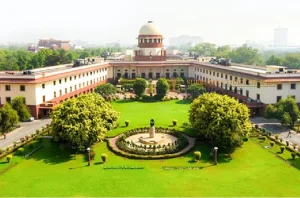

The Parliamentary Standing Committee on Virtual Courts in India
- /
- Articles and Blogposts /
- The Parliamentary Standing Committee on Virtual Courts in India
The Parliamentary Standing Committee on Personnel, Public Grievances, Law and Justice headed by Rajya Sabha MP Bhupender Yadav released an interim report on the ‘Functioning of virtual courts/court proceedings through video conferencing after the COVID-19 pandemic’. The report addresses key issues raised by users of court services on the functioning of courts online due to the COVID-19 pandemic and identifies further changes to enable the transformation of a regular court into a virtual court. The report references DAKSH research reports including the ‘Video conferencing in Indian courts: A Pathway to the Justice Platform’.
A complete virtual court
The report goes beyond the discussion of online hearings and advocates the establishment of virtual courts that harness technology for e-filing, electronic payments, better scheduling of cases, managing electronic documents and evidence.
Technological backing
The report suggest that the Ministry of Electronic and Information Technology should come up with software and hardware requirements to ‘test tools such as Immersive tele presence technology, augmented reality systems to make virtual hearings more lifelike and engaging.’The report takes into account the efforts of E-courts mission mode project in bringing in ICT infrastructure to the judiciary but is critical of the E-courts mission mode project and says that digitisation of records is moving at snail’s pace. Courts can function effectively only if court records are digitised and accessible remotely. The report points out that progress on this front has been tardy. Only states like Delhi, Karnataka and Madhya Pradesh have started the digitisation of both disposed and pending case records in the high courts and district courts.
The report highlights the technological and skills divide between the urban and rural areas. There is a lack of digital infrastructure in many district courts, according to the report, only 3477 court rooms have functional video conferencing facility, a shortfall of 14443. The report suggests the synchronisation of a centralised video conferencing infrastructure with the E-courts mission mode project with the help of Ministry of Ministry of Electronic and Information Technology and the Department of Justice.
Open court principle
The open court principle forms the core of our court system and is essential to the rule of law and the functioning of a constitutional democracy. Public trials open to members of the public help maintain public confidence in the judicial procedures and systems. Online hearings in their current form across courts in India do not always allow the public to freely watch the hearings. The report addresses the need of fulfilling the open court principles when setting up a virtual court and suggests that live steaming of cases should be available to the public. The report noted that in 2018, the Supreme Court had, in Swapnil Tripathi vs. Supreme Court of India, espoused the benefits of adopting technology in the judicial system, particularly live streaming of court proceedings.
Next Steps
The way forward section of the report recommends that prioritisation and classification of cases are important steps to identify the kind of cases should be heard in a virtual court. The report suggests cases should be classified as simple and complex classes. Complex cases require multiple witness examinations and complex procedures. Traffic challan cases, negotiable instrumental cases, petty cases are simple cases that can be heard in a virtual court even after the pandemic. The report states the implementation of the virtual court should be tried on a pilot basis, echoing the suggestions made in DAKSH’s paper. The findings from the pilot should inform the implementation of virtual courts in other courts.
For the purpose of this interim report, the committee engaged with different stakeholders in the justice system like the Department of Justice and the bar associations members. Opinions and insights from the bar association members in the report show their willingness to engage in the process of implementing virtual courts. The report recognises that virtual courts have shortcomings and have suggested means to overcome these shortcomings. It has emphasised the need to bridge the digital divide across three parameters: access, connectivity and skill. The report recommends permanent virtual proceedings for appellate tribunals like Telecom Dispute Settlement Appellate Tribunal, Intellectual Property Appellate Tribunal, and National Company Law Appellate Tribunal.
The report is crucial for continuing the conversation on virtual courts in the Indian judiciary. The report is first of its kind by a parliamentary committee on the functioning of the judiciary. It is heartening to see parliamentarians support technological transformation of the justice system after considering views of all stakeholders. DAKSH’s White Papers on Next Generation Justice Platform charts the course to be undertaken over the next 5 to 10 years. We hope that the committee regularly tracks the developments and actual progress on the ground with the same enthusiasm in the future.
The views expressed in this article are solely those of the author’s and they do not represent the views of DAKSH.

Amulya Ashwathappa
RECENT ARTICLES


Lessons for Judiciary from Space Sector

The missing piece in India’s reform story—a strong tribunal system

Fast-track courts may not be the cure

-
Rule of Law ProjectRule of Law Project
-
Access to Justice SurveyAccess to Justice Survey
-
BlogBlog
-
Contact UsContact Us
-
Statistics and ReportsStatistics and Reports
© 2021 DAKSH India. All rights reserved
Powered by Oy Media Solutions
Designed by GGWP Design